Effect of adding desulfurization gypsum and red mud on properties of composite cement-soil
0 Introduction
Cement-soil is a kind of composite soil with improved material strength, which is obtained by mixing soft soil with additives and coagulating and hardening through physical and chemical reactions. Cement-soil is more economical than concrete materials, but in large-scale projects, the amount of cement is also relatively large and the cost is high. Therefore, many scholars consider adding other additives to reduce the amount of cement while maintaining the good performance of the materials. Among them, desulfurization gypsum is a common additive, which is mainly used in combination with slag and fly ash to prepare cementitious materials and building materials.
Fluegas gypsum (FGD) is a kind of waste residue produced by coal-fired power plants, which contains a lot of calcium sulfate dihydrate minerals, showing a certain viscosity. Red mud is an industrial waste residue produced in the preparation of alumina, which has the properties of large specific surface area, small particles and some potential active gelling substances, and can be used as building materials and mine fillers. Some scholars have found that there is excitation between FGD and red mud, which can be used together to prepare curing agent.
At present, the utilization rate of FGD and red mud at home and abroad is very low, but its output and reserves are increasing year by year. Therefore, in this paper, the two kinds of solid wastes are used together to prepare composite cement soil, and the composite influence of solid wastes on the strength and stress-strain of cement soil is studied to broaden its application in engineering.
1 Experiment
1.1 Test materials
The photo of the test material is shown in Figure 1. The cement (Figure 1(a)) is 42.5 # ordinary portland cement, the FGD (Figure 1(b)) is from a power plant in Taiyuan, and the soil (Figure 1(c)) is from a construction site in Taiyuan, Shanxi. After testing, the specific gravity of soil particles GS = 2.7, liquid limit ω L = 25.2%, plastic limit ω P = 15.3%, plastic index IP = 9.9, clay content 19.6%, silt content 78.7% and sand content 1.7%. According to the standard GB 50021-2001 (2009 edition), it can be judged as silt. The red mud (Figure 1(d)) is made of Bayer red mud with plasticity index Ip=11.9, clay content of 59%, silt content of 27.3% and sand content of 13.7%. According to the standard, it has the properties of silty clay. The main chemical components of each test material are shown in Table 1.


1.2 Test method
According to the Standard of Test Methods for Basic Performance of Building Mortar (JGJ/T70—2009), the solidified soil was prepared according to the schemes in Table 2 (the percentage of each material is based on the weight of dry soil). In each scheme, the total amount of solid waste (FGD+ red mud) and the proportion of cement in soil remain unchanged, while the proportion of two kinds of solid waste changes. When the prepared samples are cured to the age of 7 days, 14 days and 28 days, the unconfined compressive strength, stress-strain, SEM, XRD and pH value are measured.

2 Results and discussion
2.1 Stress-strain curve
Fig. 2 is the stress-strain curve of 14d composite cement soil. The curve begins to be concave, and the original fine cracks and pores in the test block are constantly squeezed under the action of external force. With the increase of strain, the stress rises continuously and reaches the peak. Among them, the peak stress of the test block in Scheme 6 is the largest, which is about 8 times higher than that in Scheme 1 (σ 1 = 1.35 MPa, σ 6 = 10.80 MPa). At the same time, the slope of the curve is gradually increasing, that is, the elastic modulus of composite soil is increasing. This may be due to the different particle sizes of red mud and FGD, which can fill the test block, or it may be that the different ratio of red mud and FGD intensifies the reaction inside the test block, produces more cementitious materials, and leads to the increase of elastic modulus. With the continuous increase of strain, the material appears stress softening after reaching the peak stress. In addition, with the increase of desulfurization gypsum content in solid waste, the peak strain of composite soil decreases, which shows that the material ratio has an influence on the toughness of composite cement-soil and makes the material brittle.
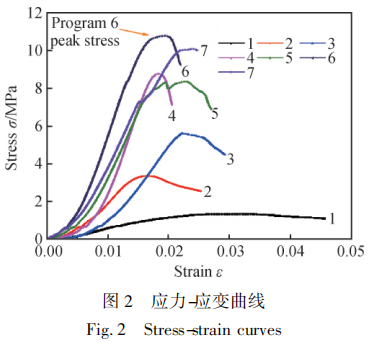
Fig. 3 shows the crack development of the test block during compression. As can be seen from the figure, in the uniaxial compression stage, many original small cracks or holes of the test block are gradually compacted under the action of external force. With the increase of strain, small cracks begin to appear on the surface of composite soil block, and gradually expand into larger cracks (as shown in Figure 3(a)). When the stress-strain curve exceeds the peak stress, cracks are constantly generated, and the existing cracks develop rapidly and continuously (as shown in Figure 3(b)), which eventually leads to the failure of the test block.
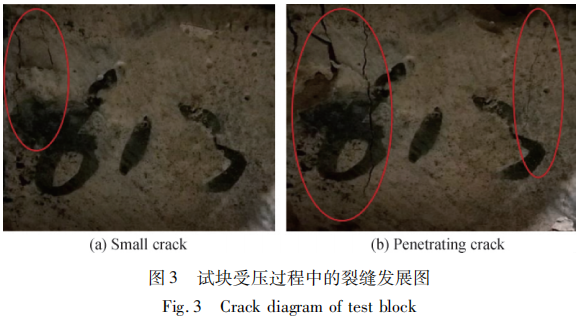
2.2 Unconfined compressive strength changes with FGD content
Fig. 4 shows the curve of unconfined compressive strength of solidified soil with FGD content when the total amount of solid waste is constant. The strength curve shows an upward trend, and the increase rate is first large and then small. The curve can be divided into two regions, A and B, with FGD∶ red mud =1∶1 as the boundary. The ratio of FGD∶∶ to red mud in area A is less than 1 ∶1, and that in area B is more than 1 ∶ 1. In area A, the strength of the test block increases steadily with a large increase, and the strength value increases from 1MPa to about 8MPa. In area B, the growth trend of the curve slows down, and the change range of the strength of the test block decreases. It shows that there is a better proportion between FGD and red mud, and the increase of FGD proportion will improve the strength properties of solidified soil.
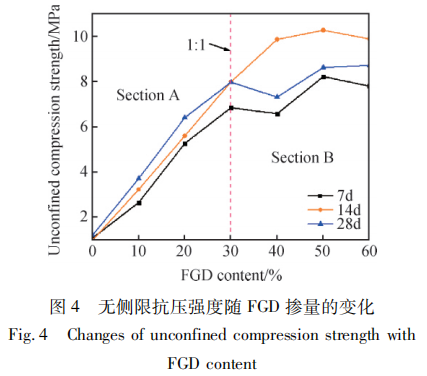
The curve shows different trends in two regions, A and B, which may be caused by the influence of FGD content on ettringite. When the pores in the test block are large, in the presence of FGD, the hydration reaction of active substances in cement and red mud will produce fine needle-like ettringite; When the content of FGD increases gradually, the structure of ettringite changes, and the ettringite formed gradually changes from fine needle to long rod, short column and hexagonal column, which makes the structure more dense and tends to increase in strength. However, when FGD is added to a certain extent, its influence on the compactness of the internal structure of the material decreases, and the decrease of red mud content changes the alkaline environment for ettringite production, so the increase of strength becomes gentle.
Fig. 5 shows the SEM photos of soil and solidified soil. There are many irregular pores in the soil, but the pores in the solidified soil are filled and bonded by fine particles and cements generated by hydration reaction, so that the structural density and strength are improved. The hydration of active substances in red mud and substances in cement will produce cementing substances such as hydrated calcium silicate gel and hydrated calcium aluminate. The smaller particle size of red mud will play a filling role in the pores in the structure, and the viscosity of FGD will improve the structural integrity. In addition, in the alkaline environment of red mud, the active substances such as tricalcium aluminate and tetracalcium ferric aluminate in the test block will react with CaSO4·2H2O to form ettringite. These physical and chemical reactions will fill the pores of the test block, which will improve its integrity and strength.
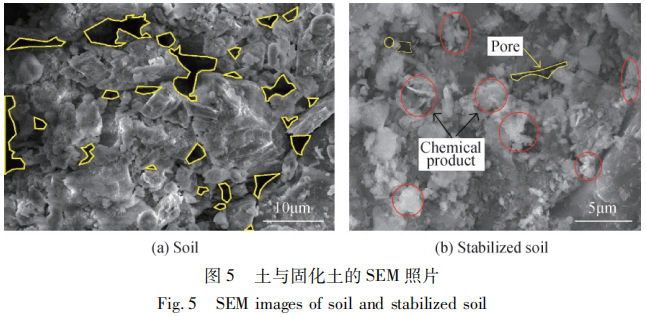
2.3 The relationship between unconfined compressive strength and age
Under each scheme, the histogram of unconfined compressive strength of test block changing with age is shown in Figure 6. When FGD∶ red mud < 1 ∶ 1, the strength increases with the increase of age, and the increase range is relatively stable; When FGD∶ red mud > 1 ∶ 1, the strength of the test block decreases in the later stage.
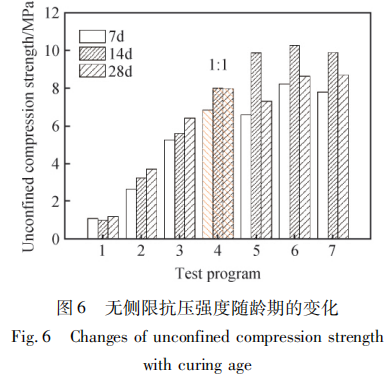
In the process of mixing materials with water, soluble substances dissolve, and Ca2+, SO2-4 and ALO-2 appear in the liquid phase, which will react with each other to generate ettringite in alkaline environment. In the hardened body, with the increasing curing age, ettringite generated by the reaction interpenetrates with other hydration products in the form of microcrystals, forming a dense structure, which increases the strength of the hardened body. In addition, soluble salts in FGD are beneficial to accelerate the hydration reaction of cement.
Fig. 7 shows the XRD spectrum of the solidified soil when the FGD content is 30%, and fig. 7(a) shows the mineral composition analysis of the test block after 7 days of curing. From the figure, it can be seen that there are substances such as SiO2, CaSO4·2H2O, CaCO3 and CaAl2Si2O8·4H2O in the solidified soil. Figure 7(b) shows the composition analysis of 28d solidified soil with the same material ratio. Compared with Figure 7(a), some peaks in the figure disappear, and the mineral composition at some peaks changes, indicating that the age has an influence on the mineral composition in the test block.
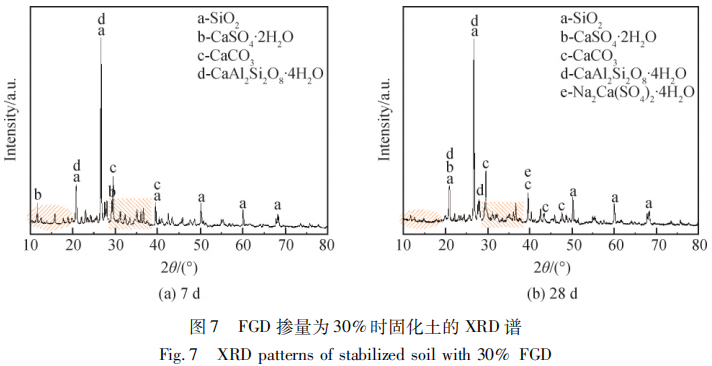
2.4 Relationship between unconfined compressive strength and pH value
Fig. 8 shows the relationship between unconfined compressive strength and pH value of the corresponding test block at each age and each ratio. There are no points distributed in area A, but the points distributed in area B are the most. The intensity value in area A is relatively small, with the maximum value of about 4MPa, while the intensity value in area B can reach about 11MPa, and the intensity values at all points in area B are relatively large.
Ettringite exists in a pH range of 10.5 ~ 13, of which 11 ~ 12.5 is the most stable environmental condition. Therefore, the alkalinity of red mud and Ca(OH)2 generated by cement hydration are beneficial to the formation and stability of ettringite, and also have a positive effect on the hardening reaction of cement. On the other hand, with the increase of pH value, the liquid plastic limit of the material is constantly increasing, and colloid ions that were originally dissolved in alkali liquor during the plastic limit will gradually separate out colloid, and these colloid will continue to play a cementing role, which will increase the strength of the test block. In addition, with the increase of pH value, the clay content in the soil increases, which will make the test block form a denser whole and improve its strength.
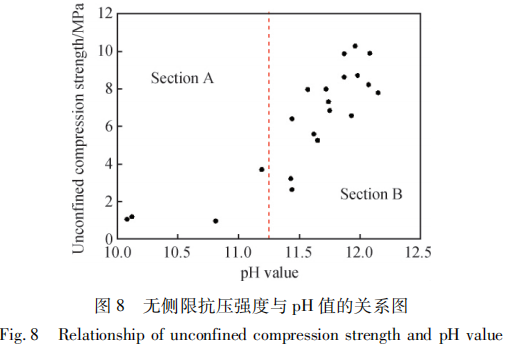
3 Conclusion
The main results are as follows:
(1) The stress-strain curve of solid waste composite cement-soil is softened, and its elastic modulus increases with the increase of the ratio between desulfurization gypsum and red mud, and the ability of resisting deformation of the material is enhanced. In addition, with the increase of FGD, the brittleness of the material develops.
(2) The unconfined compressive strength of solid-waste composite cement-soil is influenced by factors such as the proportion of solid waste, curing age and pH value. With the increase of the proportion of solid waste and curing age and the enhancement of alkalinity, the unconfined compressive strength value gradually increases. Among them, the increase of pH value will increase the clay content and precipitated colloid in the test block, and alkalinity is beneficial to the formation of ettringite, which plays a joint role in improving the strength of the material.
(3) Micro-analysis and macro-results show that adding proper proportion of FGD and red mud can improve the internal structure of cement-soil and significantly improve its strength. Therefore, we can consider adding these two kinds of solid wastes into cement soil to improve its compressive capacity, and provide a new scheme for the safety of the project and the utilization of solid wastes.
Source:https://mp.weixin.qq.com/s/IB2I6oLNshRYgJK33-OQkA
